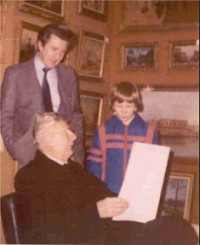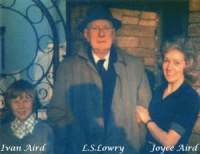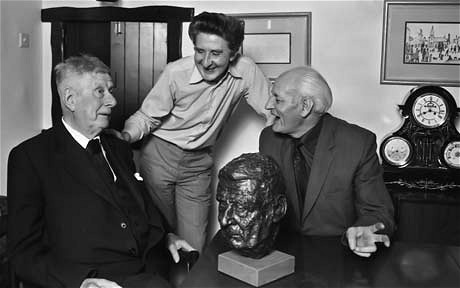

Original paintings and prints for sale from leading artists including L. S. Lowry.
View Our CatalogueIt is with deep regret that we announce the death of our director, Ivan Aird, following a period of illness.
Grove Fine Art has an unrivalled specialist knowledge in L. S. Lowry originals, based upon a long standing family relationship with the Salford artist. This puts Grove Fine Art in a unique position in the art world as our company directors have personal knowledge of Lowry's working methods, source material and background, dating back over 40 years.
L. S. Lowry was a frequent visitor to our director's family home in Cheshire on most Saturdays during the 1960's and up to the mid 1970's. During this time Mr George Aird was buying a major proportion of the artist's work directly from Mr Lowry, and this was the part of the childhood environment that Ivan Aird grew up with and gradually developed a life-long passion for the highly distinctive, collectable and Internationally famous artist that Lowry has now become.
Click the button below to read Ivan Aird's fascinating account of his childhood memories with L. S. Lowry.




I was Mr Lowry’s agent, and another client of mine said that a sculptor called Sam Tonkiss, who was relatively well known at the time, would like to make a bust of him. So I asked Mr Lowry if he would sit for it, and he said yes. Mr Tonkiss [right] made the bust in clay over a number of sittings, then sent it off to a factory in Birmingham to be cast in bronze. This photograph was taken at my house in Manchester when Mr Tonkiss showed Mr Lowry the finished bust for the first time. Mr Lowry was very pleased with it, and said so, but I don’t think he would have said anything else. I remember once I took a picture to show him and he said, 'I don’t care much for that.’ Then I said that I’d painted it and he immediately said, 'Oh, that's very, very good.’
I first met Mr Lowry when he had an exhibition at Salford Art Gallery, and he came up to me and asked me which was my favourite picture. I liked one of the pastels, it was a bit like something by the French Impressionists, and I know when I like a picture because it does something to your insides. I did like his paintings, and over the years I bought them, too. I had three Lowrys at one point – there is one on the wall in this picture – but I’ve sold them on now. The last one made quite a lot of money.
This picture was taken about a year before he died, and by then he was quite a rich man and a bit of a celebrity, but he didn’t have any airs or graces. He looks quite smart in the photograph, but when he was painting he used to wipe his hands on his suit and his coat. He kept saying he was going to buy a new suit but he never did when I knew him. We got on very well and I used to visit him at home. His house was a dump – it didn’t have hot water or anything – but he was happy with it. He had an electric fire in his front room, but it had only one bar working. He used to hold his foot by the bar; once, he burnt the bottom of his slipper. Later somebody fitted a gas fire for him and the whole room was quite warm then. He had a telephone, but you couldn’t ring him – so he would ring me twice a week and I used to take him to Stanneylands on the East Lancashire Road for lunch. We would talk about pictures and other artists. My son Ivan was quite small and he’d come with me and have a glass of milk. Mr Lowry always stretched across the table to try and pinch it. He used to say, 'If we all went to the gents at the same time then we could get out of the window without paying.’ Not that he ever would.